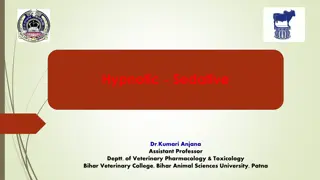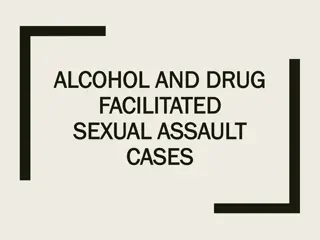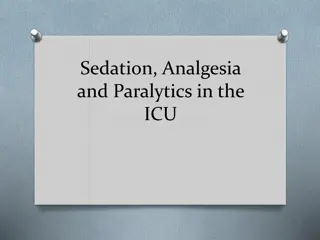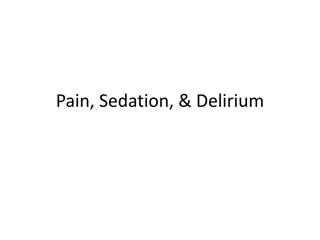Clinical Presentation and Management of a Possible Rabies Case in a 42-Year-Old Male
A 42-year-old male presented with back pain and an infected wound, later developing symptoms of fatigue, difficulty drinking water, muscle spasms, behavioral changes, and phobias. Concerns of possible Rabies led to admission, treatment with fluids, antivirals, and sedatives. Tetanus immunization was
3 views • 54 slides
Overview of Tranquillizer-Sedatives in Veterinary Pharmacology
Tranquillizer-sedatives are drugs used in veterinary medicine to reduce mental tension, induce calmness, and manage behavioral disorders in animals. The chapter covers the classification, therapeutic uses, mechanisms of action, and adverse effects of various tranquillizer groups such as phenothiazin
0 views • 26 slides
Overview of Sedatives and Hypnotics in Veterinary Pharmacology
This chapter discusses the classification, salient features, and uses of sedatives and hypnotics in veterinary pharmacology. Sedatives subdue excitement and induce calmness without necessarily causing sleep, while hypnotics induce and maintain sleep. Both classes of drugs act as CNS depressants and
1 views • 23 slides
Exploring the Roots and Meanings of Sedentary Lifestyle
Delve into the origins and significance of words such as sed, sid, sess, and their relation to concepts like settling, meetings, sedatives, residences, and sedentary lifestyles. Uncover how these roots play a crucial role in describing aspects of sitting, settling, and inactivity in various contexts
5 views • 23 slides
Understanding Alcohol and Drug Facilitated Sexual Assault
Perpetrators use alcohol and drugs to facilitate sexual assault, exploiting victims' vulnerability. This includes providing substances to create vulnerability deliberately. Participants learn defense strategies and trauma-informed investigation techniques for such cases. Recognizing what consent is
0 views • 31 slides
Classification of Drugs Acting on Central Nervous System
The Central Nervous System (CNS) plays a crucial role in coordinating the body's functions and responses to the environment. Drugs acting on the CNS can be classified into CNS stimulants and CNS depressants. CNS stimulants include spinal, medullary, and cortical stimulants, with various direct and i
0 views • 10 slides
Sedation, Analgesia, and Paralytics in the ICU: A Comprehensive Guide
This comprehensive guide delves into the use of sedatives, analgesics, and paralytics in the intensive care unit (ICU). It covers various medications like Etomidate, Propofol, Ketamine, Benzodiazepenes, and Dexmedetomidine, detailing their indications, dosages, and effects. Understanding the role of
0 views • 21 slides
Pain, Sedation, & Delirium Management in Critical Care
Effective management of pain, sedation, and delirium is essential in critical care settings to optimize patient comfort, facilitate recovery, and ensure better outcomes. The goal is to control pain adequately, minimize sedative use, and address indications for analgesia and sedatives while being min
0 views • 23 slides







